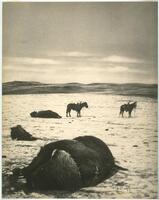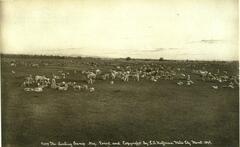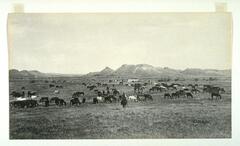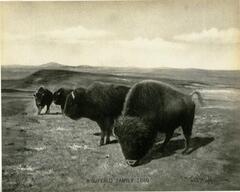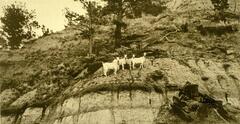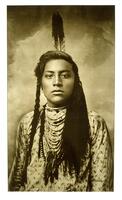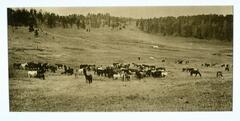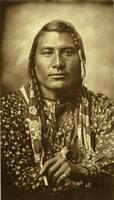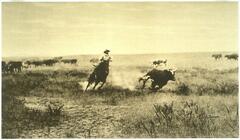Manifest Destiny and the American West
Manifest Destiny and the American West
The group of works in this resource illustrates the move of settlers and artists into Western regions of the United States. By 1850, the shape of the continental United States had been set through a series of purchases and conflicts with other European nations and had now grown into violent conflicts with the native populations. Additionally, by this time the medium of photography was widely available and portable, allowing the first photographic images of the West to circulate.
This resource allows for a critical look at the presenting and representing of the ideals of Manifest Destiny. Issues of racial stereotyping, the takeover of land from native populations, and preservation and destruction of natural resources can all be discussed in relation to this body of works. What this portfolio can also show is the shifting and changing images of the American West over time, for example: from the focus on “cowboys and Indians” of Huffman and Kenyon to the sublime natural expanses of Ansel Adams.
Work Description
Huffman, a young photographer of 25, moved to Montana in 1879 to be the post photographer at Fort Keogh, just three years after George Armstrong Custer’s defeat at the Battle of Little Bighorn, the so-called “Custer’s Last Stand.” Huffman came to know settlers and American Indians living in the area and took his “four-legged tripod” camera around to document the region. This image documents European-Americans hunting bison, an already endangered species, for their hides. Unlike the American Indians, these hunters killed bison in large numbers and only took the hides and trophy-heads, usually leaving the rest of the animal to rot. This image, as is described in Alan Braddock’s 2009 article, was later used to illustrate the plight of the American Bison and the need for wildlife conservation.
Related Article
Alan C. Braddock, “Poaching Pictures: Yellowstone, Buffalo, and the Art of Wildlife Conservation” in American Art, vol. 23, no. 3 (Fall 2009), p. 36-59.
Article Discussion Questions
What role(s) did photography play in early environmental legislation in the US?
How can one discuss the “truth value” of images in a context like the one Braddock describes, when “pictures spoke for themselves”? And what kind of social and/or moral questions does the use and reuse of images pose even today?
What role do “modernity” and “technology” play when considering works like this? What role do these concepts play when considering the idea of America’s Manifest Destiny?
Further Reading
Gene Allen and Bev Allen, “L.A. Huffman: Photographer of the West,” in Montana: The Magazine of Western History, vol. 54, no. 1 (Spring 2004), p. 76-77.
Matthew Baigell, “Territory, Race, Religion: Images of Manifest Destiny,” in Smithsonian Studies in American Art, vol. 4, no. 3/4, (Summer-Autumn 1990), p. 2-21.
==========================================================================================
Focus on Canyon de Chelly
Theme:
Edward Curtis and Ansel Adams made very different choices about how to represent Canyon de Chelly, a national monument in northeastern Arizona. Located within the Navajo Nation, the canyon preserves memories of the Anasazi and Navajo people and is one of the longest continuously inhabited landscapes in North America. Canyon de Chelly features a distinctive geological formation—Spider Rock—that rises dramatically from the canyon floor. Both photographers capture the rugged vertical cliffs and grand scale of the canyon; however, time period, cultural pressures, technical processes, and the presence of humans affect the overall feel and representation of the place. This comparison explores how photographic presentation can create different notions, or alter the perception, of the same landscape.
Studying these photographs also considers the unique history of photography and the romantic vision of the American West. It is worth noting that photography was invented at the height of the international Romantic movement, which portrayed nature as a source of spiritual meaning and individual expression. Art historian Simon Schama writes, “The idea was that wilderness is out there—somewhere—in the western heart of America, awaiting discovery and that it would be the antidote for the poisons of industrial society. Because of this desire to preserve a mythical untouched wilderness and because of the photographs of Curtis and Adams that depict that ideal, laws were passed to protect the landscapes featured in their work. As a result, many people have set off to find the specific locations of the photographs.
These photographs thus raise questions about the legacy of Romanticism on our perception of the American West, the role photography plays in the cultural creation of the notion of “wilderness,” and the relationship of photography, tourism, and environmental activism.
The Artists:
Edward Curtis
Edward Curtis (1868-1952) is best known for his landscapes of the American West and portraits of American Indians. His prolific work resulted in a twenty-volume set of photogravure prints and ethnographic notes, The North American Indian. Curtis worked in an era when scientists and anthropologists conducted ethnographic studies of “other” races, often employing photographers to “document” traditions and physical characteristics. One goal of these photographs of untouched wilderness landscapes and decorated portraits was to capture different “pure” races and their habitats before their way of life disappeared. While this practice and motivation is extremely problematic and controversial, it nonetheless created iconic images that have shaped popular conceptions of American Indians.
Curtis has not escaped scrutiny. He states in the introduction to The North American Indian that he wanted to photograph the Indian tribes that “still retain to a considerable degree their primitive customs and traditions.” In order to make the “primitive” traditions a reality, Curtis was known to remove modern technology, such as clocks or cars, from the final printing to create the impression that his subjects had no contact with the modern world. He also asked his sitters to pose with props such as feathers and baskets, which he carried with him. This manipulation has raised debate about the power dynamic between the photographer and the sitter and the artistic limits of the photographer.
Curtis worked in a style known as pictorialism, popular at the turn of the 20th century. It employed conventions such as exotic subject matter, a soft-focus, dynamic compositions, and tonal ranges that imitate nineteenth-century drawing techniques. Because photography was new and trying to be taken seriously as fine art, the goal was to appear like the established fine arts of painting or drawing. Therefore, Curtis’ photographs of costumed American Indians and isolated wilderness landscapes are often soft-focused and sepia-toned.
Ansel Adams
Born in San Francisco in 1902, Ansel Adams is arguably the most popular American landscape photographer. A concert pianist, his years of precise musical training translated into crisp and meticulous black and white prints. Historically, he may be a bridge between two photographic traditions—pictorialism (ex. Edward Curtis) and “straight” photography. The latter group began as a reaction to the soft, toned, romanticized, and “altered” pictorialism. The perception that photography was too mechanical and “realistic” to be considered fine art was still prevalent in the early 20th century. Adams and colleagues such as Imogen Cunningham and Edward Weston challenged that notion by organizing a group called f/64, named for the aperture setting that allows great depth of field and sharp focus from foreground to background. Its members approached photography as and “the natural world as if it were a collection of permanent and immutable facts.”
Despite his insistence on directly capturing the scene without mediation or manipulation, he wanted to convey the internal and personal experience that landscape, especially mountains, can evoke. He wanted as many people as possible to participate in that experience and used his photography to lobby for the creation of National Parks. He states: “The Great wilderness areas, designated for the perpetuation of the intangible qualities of nature, must be given appropriate use and interpretation, and complete protection.” An active founding member of the Sierra Club, Adams promoted preservation and conservation of the West by publishing inspiring images such as Canyon de Chelly.
Object Information:
Edward Curtis:
Taken from the vantage point of the canyon floor and photographed from a distance, Curtis quickly creates a sense of scale. The horses are dwarfed by the imposing cliff rising behind them. The tiny diagonals of their legs are reminiscent of matchsticks or cave pictograms. Horizontal striations and the open cloudless sky provide contrast to the sheer verticality of the rock. The gold tone projects an aura of nostalgia for the wild west and the closing of the frontier. The unique orotone process—precoating a glass plate with silver gelatin, then coating it with banan oil and gold-colored pigment—casts a gold glow. When light reflects on the glass and gold finish, it mimics a three-dimensional stereoscopic image, which also contributes to a sentimental feel. The actual size of the print (10½” x 13½“) is relatively small, in contrast to the monumental subject matter.
Ansel Adams
Adams photographed the canyon with no trace of human presence, including his own. Although he appears to have taken an aerial photograph, he is perched at the top of the cliff. We wonder: where was he standing? how did he haul his unwieldy glass plates up a mountain? could anyone hike down to the river? Certainly part of the appeal of this photograph is Adam’s ability to visualize and capture a landscape that is beyond the limits of human experience, or at least typical daily experience. Most days, people encounter throngs of people on the subway, lines in the grocery store, or crowded restaurants. It is attractive to envision ourselves being transported to a fantasy land of black rocks and deep skies with no one else within sight. However, by not showing humans, Adams aligns himself with landscape painters who promoted Manifest Destiny ideals; they intentionally excluded inhabitants who would need to be moved to make way for settlers and westward expansion. Canyon de Chelly was home to the Navajo people before they were expelled in two 19th century invasions and relocated to Bosque Redondo, New Mexico.
The grand scope of Adams’ photograph, as well as its projection of power, exaltation places it in the realm of the sublime. Philosopher Immanual Kant writes that although the beautiful can be small, the sublime must be great. Usually broken or rugged and raw, images of the sublime convey the sense of a heavenly power, an exaltation of the power of nature, and an uplifting inspirational awe. Imagining the time it took the winding river to cut through layers of rock, noticing the billowing clouds, and appreciating the beauty of formal beauty of the undulating lines within the rock is powerful and awesome. This particular photograph was loaned to the Eiteljorg Museum of American Indian and Western Art for use in their “Georgia O’Keefe: Visions of the Sublime” exhibition in 2005.
In addition to Canyon de Chelly, the photograph is about form. Deep black and stark white are mediated by a range of grays. Striations form undulating organic curves, and the shadow cast by the mountain creates a dynamic diagonal divide through the photograph. Adams maintains a sharp focus throughout the foreground and background, convincing us of a reality that is even clearer than if we were standing on the edge of the canyon.
Teaching Ideas / Discussion questions
1. Romanticism
Curtis and Adams could be charged with “romanticizing” the American West by creating nostalgia for a bygone age or for casting the rugged landscape as sublime. Adams has been compared to landscape photographers of the 19th century (example: Jackson and O’Sullivan) as well as painters of the sublime, such as Bierstadt. Adams might have taken exception to that classification, as he felt that Romantic artists were “sincere but limited scene painters” who commemorated external events of landscapes, but he wanted to convey the relationship of objects to one another and the inner spirit of a place.
Questions: 1) What does it mean to “romanticize” a landscape? 2) Contemporary landscape photographers challenge Romantic notions by capturing heavy automobile traffic or nuclear waste sites. Is it “not realistic” to cast a place in a Romantic light?
2. Photography and manipulation
Since its inception, photography has wrestled with its relationship with established fine arts, such as painting and sculpture. First, photographers manipulated prints to appear softer and more painterly. Then, Adams and his colleagues embraced the unfiltered reality of the camera. Recently, especially with the advent of digital photography, it is acknowledged that photographers make choices that influence all stages of the photographic process—composition, editing, printing. Questions: 1) What is at the heart of the controversy surrounding Edward Curtis’ intervention and manipulation? Is it more cultural than artistic? 2) What is permissible for a photographer to alter? What changes are within acceptable limits? 3) Is there inherent contradiction between Adams’ desire for “straight photography” and his sublime portrayal of the canyon?
3. Human presence and conservation
Part of Adams’ motivation was to draw visitors to see Canyon de Chelly, to encourage them to see natural wonders, and to inspire other photographers to capture rugged beauty. He was also concerned that people would simply see the view and not experience nature. Ironically, partly because of his advocacy and inspiring photographs, each year increasing numbers of tourists strain the land and make it impossible to maintain in its “unimpaired form.” The dilemma that he could not have foreseen is that the wild areas that he once publicized and saved from loggers or miners have become loved to death by backpackers. Art historian John Szarkowski notes that “to photograph a beautiful spot is not necessarily to do a great favor to its future.” Questions: 1) Is it possible to simultaneously promote and conserve a place? 2) Can an artist predict or control the viewer’s response?
4. Purpose of wilderness photography
Adams’ contemporary, photographer Henri Cartier-Bresson questioned if landscape photography could be justified when large problems exist in the world. He said, “The world is going to pieces and Adams and Weston are photographing rocks!” Adams responded to Cartier-Bresson’s exclamation, stating that landscape has social significance because every physical aspect of a region affects the psyche and physical appearance of the people who experience it. Adams photographed to protect the “spiritual potential” of rocks and landscape. He wrote: “there is some deep personal distillation of spirit and concept which molds these earthly facts into some transcendental emotional and spiritual experience.”
Questions: 1) Why photograph landscapes? Do wilderness photographs “do” anything or are they merely beautiful pictures of mountains? Is that enough? 2) What is valuable – beautifying the world, inspiring people to travel, conserving the land, encouraging personal introspection?
K-12 Teaching:
Compare / Contrast: Depending on the age of the student, make a list of the differences between the two images (human presence vs. devoid of people, orotone vs. gelatin silver print, low horizon line vs. elevated perspective and high horizon line). Practice organizing this information in either a block format or a point-by-point format. Older students could write an essay analyzing how the differences affect the over all effect of the photographs.
Creative writing: Imagine encountering Canyon de Chelly on horseback. Describe the landscape as if you were writing a postcard to friends who had never seen it.
22 Tags & 0 Keywords
Tags
American cultureAmericas
Empires
European-american culture
Frontiers
Gender
Identity
Ideology
Indigenous cultures
Landscapes
Manifest destiny
Nation and nationalism
Native american history
Natural resources
North america
Race and ethnicity
U.s. culture
U.s. history
U.s. west
United states
Westward expansion
White culture
7 Links
Tags
American cultureAmericas
Empires
European-american culture
Frontiers
Gender
Identity
Ideology
Indigenous cultures
Landscapes
Manifest destiny
Nation and nationalism
Native american history
Natural resources
North america
Race and ethnicity
U.s. culture
U.s. history
U.s. west
United states
Westward expansion
White culture
Rate this Resource
AVG: 0 | Ratings: 0
& Author Notes
Creative Commons by-nc-sa (University of Michigan Museum of Art)Last Updated
February 17, 2021 11:33 a.m.Report
Reporting Policy
